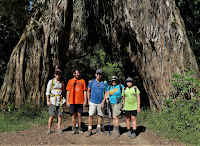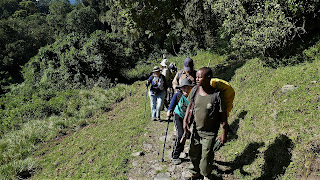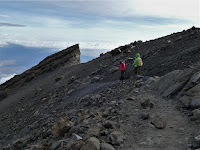People climb mountains for all kinds of reasons. Some really want to summit the highest peak – to conquer. Some people really want to know what it is like in that other world of the mountain forest and alpine zone. We have been gazing up at Mt. Meru for the past 3 and a half years, with both of those motives, wondering when we might finally get to walk those slopes. Finally, this past week, we did it.
We had actually booked this trip for the May Day holiday
weekend with Memorable Safaris. That
plan went out the window when we departed Tanzania in March for the COVID
lockdown. And good thing too! It was pouring down rain non-stop here in Arusha
until the beginning of July, so it would have been miserable, slippery hiking
through rain and mud. Memorable safari was happy to rebook us during this super
dry month of October, and we were very happy to give the business to a company
run by friends from our church. The plan was for Paul and Oren to summit, and
for David and me to stay back at Saddle Hut and wait for them. Both because of
David’s age and our mutual fear of heights, that seemed like a wiser plan.
DAY ONE
We had a relaxed start to our trip, which was good, giving us a chance to double-check all our gear and wash the dishes before our departure. Our head guide, 'Sunday', rolled up in a coaster bus at around 10 am, with five porters already aboard. Our fellow traveler Ellen was also already on the bus – she’s married to the guy who runs the company, so we were pretty sure things would go well! We also met our second guide William and the cook Emmanuel. While we drove, we quizzed Sunday about his experience and learned that he has been working to support treks for almost 20 years (first a porter, then a cook) and guiding for 9. We did the math and estimated that he’s probably summited Kilimanjaro 400 times, and Meru probably half that many. That’s a lot of experience!
Along the way to Arusha National Park, we picked up another five porters to complete our support team of 13 people (!!). Besides carrying our 4 duffle bags, they had to carry food for the whole team, cooking gear, and even an oxygen tank because we were trekking with people under 18 years old. We had just a few minutes at the park gate while Sunday checked us in and went through the formalities, enough time to look carefully at the 3-D scale model of Mt. Meru and try to figure out exactly how we would get up the mountain. It’s another 30-minute drive to Momella gate where we left the bus, and we spotted a few large herbivores along the way (zebra, buffalo, warthogs). Since it was already noon when we arrived, we had our box lunch under a shady shelter (enough food for 2 meals!) and prepared ourselves to start walking.
When hiking in Arusha National Park, it is mandatory to be guided by a Park Ranger with a gun, because the forests are full of dangerous Cape buffalo and the odd leopard. Ranger Julius was not a lot taller than David, armed with a very cheerful smile and a thirty aught six hunting rifle (an old bolt-action WW I design). Julius led the way up a steep dirt/gravel road heading up the mountainside – a road that we had actually driven twice when we did day safaris in Arusha National Park.
 |
| Overhung trees |
 |
| Forest path |
At that point, I also realized that Oren was not doing so well. Both he and Paul had woken up Monday morning with the beginnings of head colds. But Oren was really sniffling and feeling chilled as we walked. He really just wanted to arrive at our campsite, and it was pretty tough for him to enjoy the walk. David had fun watching a family of black and white colobus monkeys passing through overhead. But shortly afterwards, he decided that this whole hiking thing was no good at all, wanted to go back home, and started throwing large sticks in his frustration.
 |
| David with Julius, the Wazee |
We had another two hours of hiking up increasingly steep
slopes on this narrow path, and I won’t lie, my heartrate must have been up to
at least 140 bpm. I was really glad when Ellen started recounting stories from
her life to me, because I was so out of breath, I couldn’t get out more than
one sentence at a time. I just kept asking her questions. 😉
Still, I was thoroughly enjoying myself!
 |
| Sunrise at Miriakamba, Meru in background |
DAY TWO:
We set off up through more Montane Forest on a very steep path. Much of it was actually paved with concrete because otherwise, it would be slippery and impassable in the rains. And there were sections that were literally at a 45-degree angle. One of the highlights of the morning was briefly spotting a male turaco, as it jumped from one tree to the next, flashing a ringed eye and vibrant red wings. We took frequent breaks to make sure David could keep up the steep walk and entertained him by playing “I’m thinking of something” (20 questions). Ellen was such a good sport, playing along with these family games and helping David stay in good spirits. Oren just put in earphones, listened to music, and concentrated on putting one foot in front of the other.
One of the amazing things about Mt. Meru is that it used to be a much larger volcano than Kilimanjaro. At some point, a violent eruption carried off three quarters of the mountain, leaving a steep, semi-circular crater, with slightly more gradual buttresses leading up to a saddle area on the north side. From Miriakamba hut at sunrise, we could see the ash cone rising up from the center of this crater area. Our hike led us, by a series of steep switchbacks, up the arm of the mountain. I knew the climb was supposed to be very steep, so I was unsure what it would be like to climb this high into the edge of the crater.
 |
| Dusty heathlands |
The paths were also extremely dusty. We also found that
we could not help but kick up huge clouds of this volcanic dust as we walked,
and so we had to keep some distance between ourselves.
 |
| Meru peak looming above saddle hut |
We had an earlier dinner, and then Ellen and Paul
prepared themselves with all their gear and clothes for summitting. Oren had
planned to go with them originally, and I had no doubt that he could do it
physically. But there was no question of him starting a midnight hike when he
was running a temperature. So, unfortunately, he did not get to experience that
part of the hike. I’ll let Paul tell that part of the story…
 |
| Looking down at the ash cone |
At different times we crossed the main ridge which was immediately evident, even without light because of the intense gusts of wind that assaulted us as soon as we were exposed on both sides.
By 4:30 am we were aware of some larger jagged peaks looming ahead of us, but it was impossible to tell how far or how much higher they were. In fact, a number of times I thought we were nearing the highest summit when it just turned out to be one of the jagged peaks along the way.The graying morning came just before 6am, although we were on the side of the ridge away from the sunrise, and still a half-hour from the summit. We passed a last small saddle in the ridge and I looked up at the giant last jagged tooth looming before us. The climb to the summit, at that moment, seemed as far and unattainable as it did 4 hours earlier. The air was thin and the last climb was very steep. Another climb of scrambling and bouldering to the top. Only this time with a stop to rest and catch our breath every 3 or 4 steps.
At 6:30 am we reached the summit and looked over a very cloudy day far below in the valleys on both sides of the ridge. It was quite clear where we were though, and we could easily see to Kilimanjaro and down the ridge from whence we had come.It was quite cold and windy up there and we did not stay more than about 10 minutes before starting our descent. Happily, the return takes about a third of the time of the ascent, and difficult spots like the slippery sand were great for bounding and sliding quickly down. The rocky parts though were quite treacherous, and it is quite a revelation to see some of the places we were walking in total darkness.
Sunday our guide said that it is actually better to hike in the dark, 'goallessly' because if you are always seeing ahead of you it can be very discouraging as progress is so slow and the path ahead so treacherous.By the time we reached the saddle hut base camp at 10am, we were shot. The steep descent was quick but really painful on the knees and toes. We had hiked for 10 hours, 18 kilometers with only a little sleep the night before. I laid down in bed for a short nap knowing we had to make another 5km, 1000 m descent to the first base camp before the day was done.
 |
| Morning at Saddle Hut (David's photo) |
David was ready to be up at dawn along with me – we didn’t want to miss any of those amazing moments being up high. We woke on a stony island above a sea of clouds. Oren was able to get out of bed a little later. He had missed the chance to summit, and he didn’t want to miss out entirely. The fever was gone, so he decided that it would still be worthwhile to try to climb up Little Meru and see the view from there. But he didn’t want to go alone, and begged me to go with him, guided by Ranger Julius. David, meanwhile, was keen to cover some new ground (now that climbing higher was optional, he had a much better attitude about it!). So, he agreed to go with two of our porters to hike up Rhino point on the southern side of the saddle, which is just as high as Little Meru – he had heard he might see Rhino bones up there, and he was keen on that. Also, he hoped to meet Paul and Ellen on their way down from the summit.
 |
| Oren and I at top of Little Meru peak |
The amazing botany was still all around us, but I must confess that those 3+ hours down the mountain were pretty hard. And I had not even summited! I still can’t imagine how Paul and Ellen stayed on their feet. It was just so steep that there was no way to avoid some agony in the feet and knees.
 |
| St. John's Wort |
Paul, David, Ellen and I played a lot of “Contact,” and then tried to
share as many riddles or jokes as we could think of, just to distract ourselves
from the pain. Oren was somewhere way ahead with Julius, just trying to push
forward to the next time he could get back in bed. We had some more great
Colobus sightings, and also spotted a couple of buffalo crashing through the
forest 100 m away. By the time we got to Miriakamba, Paul and Ellen could
hardly stand it, trying to wait for dinner to be ready. We had to go find
Sunday and beg him to complete our medical checks early so that we could go to
bed! All of us were tucked in by 7:45 pm.
DAY FOUR
I woke up at quarter to six, very refreshed after a solid
10-hour sleep, and just in time for sunrise. Again, it was magical to literally
watch the sun rise through a blanket of clouds over Arusha, and then shine back
on the crater wall and the ash cone. I even had a few minutes to do some birdwatching
before breakfast and identified the Kikuyu White eye and the Northern
Double-Collared Sunbird around our camp.
 |
| Homemade Bao |
We set out promptly at 8 am for more downhill walking. It
wasn’t quite as steep as the afternoon before, but still wasn’t super
comfortable. Sometimes we walked through forest, but other times we took a
straight path through long open rocky clearings on the mountainside. Every view
back was breathtaking. On one long stretch of exposed lava rock, I noticed two
parallel rows of six little indentations in the rock – it was a homemade Bao game,
drilled into the rock by Chagga shepherds long ago, a way to pass the time
while they kept an eye on their livestock. Even on the way down that day, there
were small wonders to notice and appreciate.
Finally, we hit level ground in a familiar place – the path to a marvelous waterfall we’ve visited before on walking safaris. We were glad to cool off in the spray of the waterfall, sit down for a few moments, and appreciate how far we had come. From there, we had just a short walk back to Momella gate, with plenty of game to see along the way.
Our only disappointment was that we didn’t see any giraffe on the plain that morning. We were almost back to the road when suddenly Ranger Julius spotted a tiny giraffe – probably only 5 days old. It appeared to be alone and it gazed shyly at our group for a while and then settled itself down on the ground for a rest, just 3 m from the road. This was an absolute treat for us. Hopefully mama was somewhere nearby, but we never saw her. |
| Wild jasmine on the plains |
 |
| tiny detailed alpine flower |































